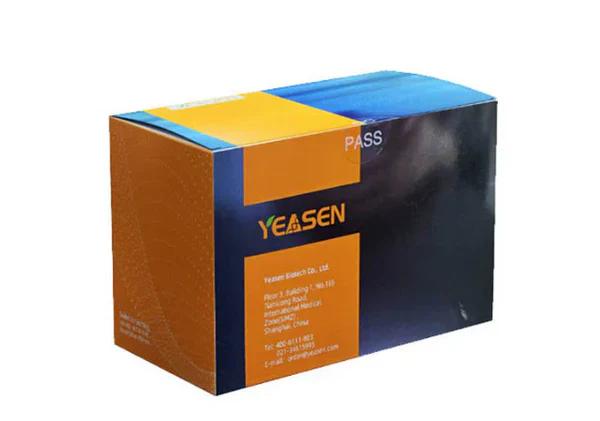Description
Phalloidin is a cyclic heptapeptide toxin derived from the death cap mushroom (Amanita phalloides). It binds to filamentous actin (F-actin) with high affinity (Kd = 20 nM) and does not bind to globular actin (G-actin). It is commonly used to label F-actin in tissue sections, cell cultures, or cell-free systems for qualitative and quantitative analysis. Phalloidin derivatives also bind to actin filaments from both animal and plant sources, including muscle and non-muscle cells, at a stoichiometric ratio of approximately one phalloidin molecule per actin subunit. Non-specific binding is negligible, providing clear distinction between stained and unstained regions. Therefore, phalloidin derivatives are particularly suitable as a substitute for actin antibodies in related research. Additionally, phalloidin derivatives are small, with a diameter of approximately 12-15 Å and a molecular weight of less than 2000 Daltons. Many physiological properties of actin are maintained, such as the ability to interact with actin-binding proteins like myosin, tropomyosin, and DNase I. Phalloidin-labeled filaments can still penetrate solid myosin matrices, and glycerol-extracted muscle fibers can contract after labeling.
Phalloidin binding inhibits the depolymerization of filamentous actin (microfilaments), stabilizing their structure and disrupting the dynamic equilibrium of polymerization and depolymerization. This property reduces the critical concentration (CC) for actin polymerization to less than 1 µg/mL, making it a potent polymerization promoter. Additionally, phalloidin inhibits the ATP hydrolysis activity of F-actin.
This product is FITC-labeled phalloidin, which offers high specificity and contrast in staining, superior to actin antibodies, and is suitable for qualitative and quantitative detection of F-actin. The labeled F-actin maintains many biological properties of actin itself, and there is no species specificity, making it widely applicable.
We provide FITC-labeled phalloidin in the form of a storage solution (20 µM concentration). Users can choose according to their needs. It is recommended to use a concentration of 80-200 nM.
Features
Binds selectively to filamentous actin (F-actin).
Phalloidin is not species-specific and exhibits virtually no non-specific staining, providing extremely clear contrast between stained and unstained regions.
It is highly compatible and does not affect the activity of actin.
Applications
The tight and selective binding to F-actin reveals the distribution of microfilament cytoskeleton within the cell.
Specifications
|
Formula |
C56H60N10O15S2 |
|
Molecular Weight |
1177.3 |
|
Excitation/Emission |
495~496/513~516 nm |
|
Sequence |
FITC-bicyclic(Ala-DThr-Cys-cis-4-hydroxy-Pro-Ala-2-mercapto-Trp-4-hydroxy-5-amino-Leu)(S-3 to 6) |
|
Appearance |
Light yellow to yellow solution |
Components
|
Components No. |
Name |
40735ES75 |
|
40735 |
Phalloidin-FITC Conjugate |
300 T |
Shipping and Storage
The product is shipped with ice pack. Can be stored at -15°C ~-25°C in a dark, dry environment for up to one year.
Documents:
Safety Data Sheet
Manuals
Citations & References:
[1] Huang K, Liang Q, Zhou Y, et al. A Novel Allosteric Inhibitor of Phosphoglycerate Mutase 1 Suppresses Growth and Metastasis of Non-Small-Cell Lung Cancer [published correction appears in Cell Metab. 2021 Jan 5;33(1):223]. Cell Metab. 2019;30(6):1107-1119.e8. doi:10.1016/j.cmet.2019.09.014(IF:22.415)
[2] Jin L, Guo X, Shen C, et al. Salivary factor LTRIN from Aedes aegypti facilitates the transmission of Zika virus by interfering with the lymphotoxin-β receptor. Nat Immunol. 2018;19(4):342-353. doi:10.1038/s41590-018-0063-9(IF:21.809)
[3] Liu J, Zhang X, Chen K, et al. CCR7 Chemokine Receptor-Inducible lnc-Dpf3 Restrains Dendritic Cell Migration by Inhibiting HIF-1α-Mediated Glycolysis. Immunity. 2019;50(3):600-615.e15. doi:10.1016/j.immuni.2019.01.021(IF:21.522)
[4] Shen C, Liu M, Xu R, et al. The 14-3-3ζ-c-Src-integrin-β3 complex is vital for platelet activation. Blood. 2020;136(8):974-988. doi:10.1182/blood.2019002314(IF:17.794)
[5] Liu Y, Lu Y, Ning B, et al. Intravenous Delivery of Living Listeria monocytogenes Elicits Gasdmermin-Dependent Tumor Pyroptosis and Motivates Anti-Tumor Immune Response. ACS Nano. 2022;16(3):4102-4115. doi:10.1021/acsnano.1c09818(IF:15.881)
[6] Zhang R, Deng L, Guo J, et al. Solvent Mediating the in Situ Self-Assembly of Polysaccharides for 3D Printing Biomimetic Tissue Scaffolds [published online ahead of print, 2021 Oct 29]. ACS Nano. 2021;10.1021/acsnano.1c05956IF: 15.8 Q1 . doi:10.1021/acsnano.1c05956(IF:15.881)
[7] Gao Y, Li X, Zeng C, et al. CD63+ Cancer-Associated Fibroblasts Confer Tamoxifen Resistance to Breast Cancer Cells through Exosomal miR-22. Adv Sci (Weinh). 2020;7(21):2002518. Published 2020 Sep 24. doi:10.1002/advs.202002518(IF:15.840)
[8] Zou M, Ke Q, Nie Q, et al. Inhibition of cGAS-STING by JQ1 alleviates oxidative stress-induced retina inflammation and degeneration [published online ahead of print, 2022 Mar 28]. Cell Death Differ. 2022;10.1038/s41418-022-00967-4. doi:10.1038/s41418-022-00967-4(IF:15.828)
[9] Lin S, Yang G, Jiang F, et al. A Magnesium-Enriched 3D Culture System that Mimics the Bone Development Microenvironment for Vascularized Bone Regeneration. Adv Sci (Weinh). 2019;6(12):1900209. Published 2019 Apr 18. doi:10.1002/advs.201900209(IF:15.804)
[10] Zhuang J, Zhang J, Wu M, Zhang Y. A Dynamic 3D Tumor Spheroid Chip Enables More Accurate Nanomedicine Uptake Evaluation. Adv Sci (Weinh). 2019;6(22):1901462. Published 2019 Oct 4. doi:10.1002/advs.201901462(IF:15.804)
Payment & Security
Your payment information is processed securely. We do not store credit card details nor have access to your credit card information.
Inquiry
You may also like
FAQ
The product is for research purposes only and is not intended for therapeutic or diagnostic use in humans or animals. Products and content are protected by patents, trademarks, and copyrights owned by Yeasen Biotechnology. Trademark symbols indicate the country of origin, not necessarily registration in all regions.
Certain applications may require additional third-party intellectual property rights.
Yeasen is dedicated to ethical science, believing our research should address critical questions while ensuring safety and ethical standards.

